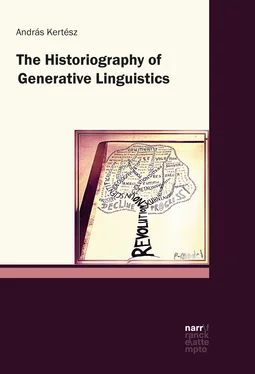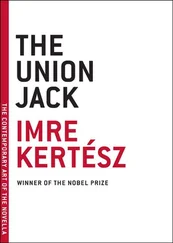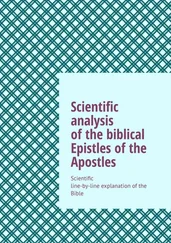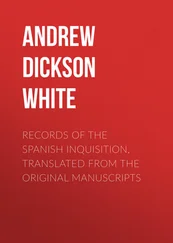If SS [Syntactic Structures Syntactic Structures ] made a revolution, the overthrown regime failed to recognize it . Certainly no revolution in linguistics was ignited by the publication of SS or by frustration at hostile and uncomprehending reaction of neo-Bloomfieldianneo-Bloomfieldians to it (MurrayMurray, Stephen O. 1994: 239, emphasis added).
Second, MurrayMurray, Stephen O. (1989: 160, 1994: 237) stresses – and in this respect he shares NewmeyerNewmeyer, Frederick J.’s (1986a: 1, 1986b: 7., footnote 6) as well as KoernerKoerner, E.F. Konrad’s (1989: 124, 2002: 185, 2004: 51) views – that in the 1950s the neo-Bloomfieldianneo-Bloomfieldian school did not undergo a scientificscientific crisiscrisis in the KuhnianKuhnian sense .3 Consequently, no revolution could break out since in KuhnKuhn, Thomas S.’s view a crisis is a necessary prerequisite of a scientific revolutionrevolutionscientific. Right at the outset, it was not the case that anomaliesanomaly emerged which neo-Bloomfieldians were trying in vain to resolve, while ChomskyChomsky, Noam offered a solution to them. On the contrary, the neo-BloomfieldianBloomfieldian linguists and Chomsky dealt with fundamentally different problems. Whereas Syntactic Structures Syntactic Structures centered on syntax, neo-Bloomfieldian linguists did not share a common view of syntax.4 Indeed, a common view was not even possible because what they considered to be the primary subject of their research was not syntax but ›phonemicsphonemics‹ (Murray 1989: 160). Besides the factors mentioned above, this circumstance, too, suggests that there could be no scientific revolution, because there was no crisis. In Murray’s view, rather than a revolution, it was a coupcoup d’état , as a result of which Chomsky and his group captured power. The coup had been thoroughly prepared and then organized by HalleHalle, Morris and others at the 1962 international linguistics conference held in Cambridge (Murray 1994: 239–240).5 In Murray’s view, the intellectual and organizational leader embodied in Chomsky’s personality played a significant role in capturing and retaining power as, under Chomsky’s leadership, the group was able to dominate and alter the institutional, organizational, and financial structure of linguistics (Murray 1994: 445).6
Third, one of the tenets of the KuhnianKuhnian approach to scientificscientific revolutionrevolutionscientifics is that the representatives of the ›old paradigmparadigm‹ reject new ideas. Seemingly, in accordance with this, ChomskyChomsky, Noam stated in several interviews, memoirs, and letters that his early attempts to be published were received adversely and his works were constantly rejected by established linguistic forums (for quotes, see MurrayMurray, Stephen O. 1994: 230–234). Murray (1980, 1994, 1999) proves the opposite of this by making reference to original documents that he thoroughly described and explored:
In the 1950s the most influential person in the Linguistic Society of America was Bernard Bloch, who worked, amongst other things, as the editor-in-chief of Language .7 Bloch’s correspondence with ChomskyChomsky, Noam documents that Bloch supported all the four papers that Chomsky submitted to Language and he paid special attention to Chomsky even when no one else did (MurrayMurray, Stephen O. 1994: 230–234, 1999a: 343–44).
Only one of ChomskyChomsky, Noam’s papers was rejected. Chomsky submitted it to Word , whose editor-in-chief was André Martinet at that time. However, Martinet did not belong to the neo-Bloomfieldianneo-BloomfieldianBloomfieldian school. Therefore, it is not the case that the emergence of Chomsky’s views was hindered by a member of the old paradigmparadigm which was to be replaced by the new (MurrayMurray, Stephen O. 1994: 229–230, 1999a: 348–351).
The documents explored by MurrayMurray, Stephen O. are in sharp contrast with ChomskyChomsky, Noam’s claim that the publication of The Logical Structure of Linguistic Theory was rejected. The manuscript was not rejected but accepted by Mouton, and two other Dutch publishers also expressed their interest in it.8 As Murray shows, it was not because the book had been rejected that it was not published in the 1950s‒1960s, but because Chomsky did not send back the contract, which had already been prepared, to the publisher (Murray 1994: 230; 1999a: 350–351; 1999b).9
LeesLees, Robert’ (1957) review, which appeared under rather unusual circumstances – all of which significantly helped to accelerate ChomskyChomsky, Noam’s career – played a significant role in the positive professional reception of Syntactic Structures Syntactic Structures in three respects. The first of these circumstances is that Lees was Chomsky’s student and thus he was not an unbiased, external expert. Second, Lees’ review was published prior to the appearance of the book to be reviewed, namely Syntactic Structures .10 Third, it was unusual that Bloch placed the review of a book by a then unknown author above the reviews of the books of two other linguists.11
Consequently, according to MurrayMurray, Stephen O. (1994: 244; 486–487), what occurred is the opposite of the KuhnianKuhnian process of revolutions, because it was not the supporters of the old system who attacked the supporters of the new theorytheory, but the other way round. Accordingly, the reception of generative linguistics in the 1950s and 1960s is in sharp contrast with KuhnKuhn, Thomas S.’s model:
[…] a major anomalyanomaly is that the conflict between generations was not instigated by the older generation rejecting the younger generation’s innovation. Chomskian work was published, sought out and taken seriously by major neo-Bloomfieldianneo-Bloomfieldians. The most central of them actively fostered ChomskyChomsky, Noam’s and LeesLees, Robert’ careers. In terms of aggression, the Chomskians struck first . Their revolutionaryrevolutionary rhetoricrhetoric was not a reaction to the incomprehension of the ›establishment‹, nor a defense against neophobia or persecution by angry elders (MurrayMurray, Stephen O. 1994: 244; emphasis added).
MurrayMurray, Stephen O. also claims:
[…] it bears stressing that the KuhnianKuhnian expectations fostered by ChomskyChomsky, Noam, LeesLees, Robert and their followers is rejection by the ancient régime pushing people to become revolutionaries. The evidence for such rejection by the neo-Bloomfieldianneo-BloomfieldianBloomfieldian regime of linguists during the 1950s is not merely lacking, but the evidence (points) in the opposite direction, i.e., rather than rejection there was encouragement – and even solicitation from those controlling the means of linguistic publication (MurrayMurray, Stephen O. 1999: 351; bold emphasis added).
Thus, MurrayMurray, Stephen O. argues that, contrary to ChomskyChomsky, Noam’s reports and NewmeyerNewmeyer, Frederick J.’s (in Murray’s view) »propagandistic« claims, the young Chomsky was not the solitary hero fighting against the incomprehension and the attacks of the conservative elder generation, but that he enjoyed the support of the latter. In his review of Murray’s book, JosephJoseph, John E. (1995: 382) evaluates this as an »unparalleled« finding, which was »a big bombshell« (Joseph 1995: 388). Newmeyer (1986a: 36), in contrast, calls these conclusions, also discussed in Murray (1980), into question.
Based on the analysis summarized above, MurrayMurray, Stephen O.’s dual model makes the following crucial generalization:
Changes in science are made by groups, not by the automatic breeding of ideas by other ideas, nor by single individuals, however brilliant their thoughts and research. […] There does not seem to be any relationship between the novelty of ideas and the claims to novelty . Major changes in assumptions may be made by groups wrapped in the mantle of tradition […], while minor changes may be heralded as epoch-making breakthroughs after ›dark ages‹. […] Finally, the causal direction posited by KuhnKuhn, Thomas S. to explain scientificscientific revolutionrevolutionscientific – viz. that rejection of new ideas leads to a counter-community – needs to be reconsidered. In the case of transformationaltransformation grammargrammar, the younger generation attacked elders who had been facilitating the diffusion of TGG work, rather than the elders attacking those daring to put forth new ideas (MurrayMurray, Stephen O. 1994: 486; emphasis added).
Читать дальше












